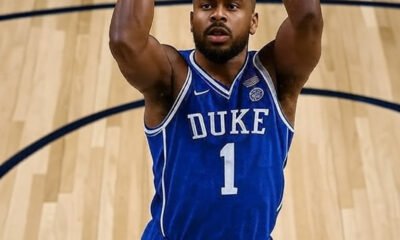Blog
Adam Smith, No.1 player in America, stands 8.5-foot-tall committs to Cincinnati Reds football team over Tennessee vols and Georgia….
Adam Smith, No.1 Ranked Player, Commits to Cincinnati Reds Football Over SEC Powerhouses
The world of college football is abuzz after the stunning announcement that Adam Smith, the nation’s top-ranked recruit, has pledged his future to the Cincinnati Reds football program. The 8.5-foot-tall behemoth has seemingly defied conventional wisdom, selecting a program with a less-established football presence over the prestigious Tennessee Volunteers and Georgia Bulldogs. This unprecedented decision has sparked a flurry of speculation, analysis, and excitement, igniting debates about the future of recruiting, athletic development, and the evolving landscape of collegiate sports.
Smith’s colossal height, a defining characteristic of his already impressive profile, has undeniably captured the attention of the nation. Few, if any, players in recent memory have possessed such a remarkable physical advantage. While height is certainly a noteworthy asset, it’s not the sole factor in determining success in any sport. The question now is whether Smith’s unique dimensions will translate into on-field dominance at the college level, and how the Cincinnati Reds will manage the challenges of integrating such a prodigious talent into their program.
The Cincinnati Reds, a team often associated with their baseball prowess, have surprisingly made a significant commitment to football in recent years. This commitment to expanding their athletic offerings has been met with mixed reactions. While the move to acquire a top-tier recruit like Smith is certainly a bold step, it raises questions about the long-term sustainability of the program. Can the Reds provide the necessary infrastructure, coaching staff, and resources to nurture Smith’s talent and ultimately guide him to success?
The choice of the Cincinnati Reds over traditional powerhouses like Tennessee and Georgia is certainly a departure from the norm. Both Tennessee and Georgia boast rich football histories, storied rivalries, and established support systems. The question is whether Smith’s decision was driven by a desire for a unique playing experience, a more personalized approach to development, or perhaps even a different vision for his future beyond the traditional football career path.
This decision will undoubtedly be scrutinized by experts and analysts alike. Will Smith’s immense size translate into dominance on the gridiron? Will his unique physical attributes create a competitive advantage, or will they ultimately hinder his performance due to the unfamiliar demands of the game? The Reds will face a monumental task in adapting their playbook and training protocols to accommodate Smith’s singular physique.
The media has been quick to analyze Smith’s choice. Some have pointed to the potential for Smith to redefine the very notion of a “tall” football player, while others question whether his size alone will be sufficient to overcome the tactical and strategic challenges inherent in the sport. The recruiting landscape is constantly evolving, and Smith’s commitment is a tangible example of this evolution. The strategic decisions of the Reds, and the long-term implications of Smith’s choice, will be closely observed as the upcoming season approaches.
Smith’s decision highlights the evolving dynamics of collegiate athletics. The traditional powerhouses, with their established legacies and resources, may be challenged by the emergence of new programs and innovative approaches to recruiting. Smith’s commitment to the Reds represents a bold gamble, and the outcome will undoubtedly have a significant impact on the future of college football.
The question remains: Can the Cincinnati Reds, with their relatively inexperienced football program, successfully integrate Adam Smith into their team and ultimately achieve success? The answer, for now, remains elusive. But one thing is certain: Smith’s decision has injected a significant dose of excitement and intrigue into the college football world, forcing a re-evaluation of the traditional power structures and the potential for innovation and disruption in the sport. The future of Adam Smith, and the Cincinnati Reds football program, will be closely watched as they navigate this unprecedented path.
-

 Arsenal2 years ago
Arsenal2 years agoSad News Arsenal ex player who is goal scorer confirmed dead this morning
-

 Liverpool2 years ago
Liverpool2 years agoSad News Sadio Manè Confirmed Dead Today By Sky Sports Reporters, Open For Full Story 👇
-

 Blog1 year ago
Blog1 year ago“I was forcefully removed from Manchester United squad and now I’ve joined the best team in the world…I will revenge and as a result, I’ve ordered my friend who’s their best player currently to leave there with immediate effect and he has agreed”: Former Man United player angered by United decision to removed him from the squad as he ordered the Club’s best player to leave immediately.
-

 Blog1 year ago
Blog1 year agoSad News: Manchester United player died when playing for his country England yesterday 😢 😔
-

 Blog2 years ago
Blog2 years agoR.I.P: Formal Real Madrid and France international confirm death this morning
-

 Chelsea2 years ago
Chelsea2 years agoBreaking New:”Roman Abramovich could get Chelsea back”? Chelsea owner review the conversation between him and Roman Abramovich in. Deal about getting Chelsea back
-

 Blog2 years ago
Blog2 years agoUNBELIEVABLE: Manchester City midfielder KELVIN DE BRUYNE divorced wife this morning after DNA test revealed their 5 years old son belongs to formal Manchester United player
-

 Manchester United1 year ago
Manchester United1 year agoOFFICIAL NOW: Manchester United announce the signing of 23yr sensational player after beating Liverpool and Madrid for His signature, agreement reached on a 5yr deal, Medical completed – announcement ongoing












